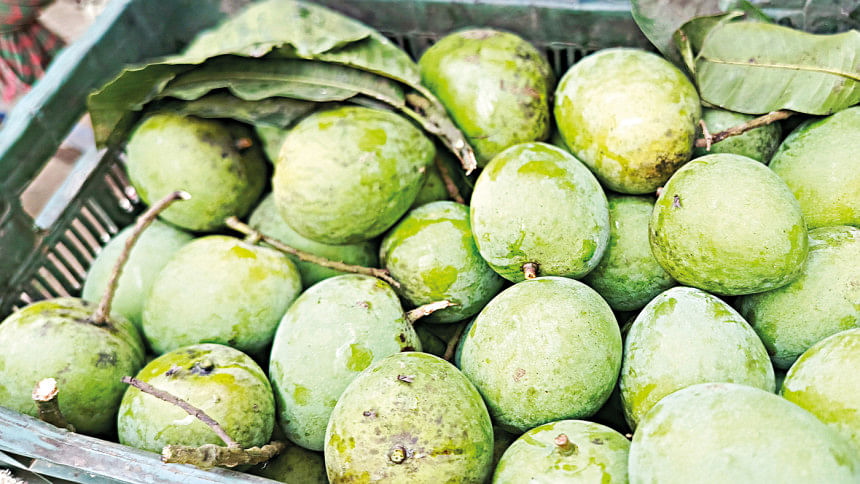Tucked away beside a mosque in the quiet village of Tekani in Rangpur's Mithapukur upazila stands a tree that once changed the course of an entire region's agricultural history.
This is no ordinary tree—it's the mother tree of the famed Haribhanga mango, a variety known across Bangladesh and abroad for its distinct aroma, rich sweetness, and now, a certified Geographical Indication (GI) status. Planted 76 years ago, this historic mango tree still bears fruit today, continuing to nurture a legacy that began with a humble story.
Locals said, as summer heat ripens the mangoes, the tree stands quietly beside the mosque—its branches weathered, its trunk gnarled, its roots deep. It is a tree, yes—but it is also history. A story still living, still fruiting.
In 1949, local farmer Nofol Uddin Paikar brought home two saplings from a nearby forest. One was stolen, but the other thrived. As the tree began to bloom, he would hang earthen pots filled with water from its branches to protect the buds—an old practice rooted in folk wisdom. But mischievous boys from the village would often break the pots.
When buyers tasted the mangoes and asked about the variety, Nofol would chuckle and say, "These are from the tree whose pots the boys kept breaking." Thus, the name Haribhanga—literally meaning "pot-breaking"—took root, spreading by word of mouth until it became legend.
Nofol Uddin passed away in 1969, but his son Amzad Uddin Paikar, 68, carried on the care of the tree. In the 1980s, grafting began in earnest, and by the 1990s, Haribhanga mangoes had spread across Rangpur and far beyond.
Today, nearly every family in Tekani village owns Haribhanga mango trees—ranging from 200 to 2,000 per household. The mango has transformed the local economy; farmers now cultivate the fruit commercially and have even started nurseries to sell grafted saplings across the country.
The saplings have made their way to India, Malaysia, and Saudi Arabia, establishing the Haribhanga name well beyond Bangladesh.
"This tree isn't just a tree—it's part of our identity," says 80-year-old Lutfar Rahman, a local farmer. "I've planted over two thousand trees grafted from this one. We're proud that our village gave birth to something the whole country now cherishes."

Eighty-five-year-old muazzin Momdel Hossain has served the Tekani Jame Mosque next to the mother tree for over 40 years.
"Every day people come from faraway places to see the tree," he says. "Not just for its fruit—but to hear its story."
Farmer Ansar Ali, 77, reflects on how the mango was born out of a simple joke:
"No one knew about this mango before. Now, it's a national pride. People won't find any other mango variety in our village anymore."
Amzad Uddin Paikar, now 68 and in poor health, continues to guard the tree planted by his father. His family land has shrunk to just 50 decimals, of which the mother tree occupies 14.
"This tree once gave us 30-35 maunds of fruit every season," he recalls. "Now it's only 7-8 maunds. It's getting shorter, ageing. But I use no chemicals, and that's why its taste and aroma are still unmatched."
Buyers from Rangpur city still come directly to his home to buy mangoes from the original tree, often paying premium prices.
Despite financial hardship, Amzad refuses to cut the tree or sell the land.
"I could clear the land for other crops, but I won't. I've told my son Firoz—this tree must be protected, even after I'm gone." He has officially appealed to the government to preserve the tree.
Data from the Department of Agricultural Extension (DAE) in Rangpur shows that Haribhanga mangoes are being cultivated on 2,567 hectares of land across Rangpur, Lalmonirhat, Kurigram, Gaibandha, and Nilphamari—an 11-hectare increase from last year. Of this, 1,915 hectares are in Rangpur district alone, with 80 percent of production concentrated in Mithapukur and Badarganj upazilas.
The projected output for the current season stands at 39,006 tonnes, with an estimated market value exceeding Tk 140 crore.
The seasonal mango trade officially kicked off on June 15 this year, and already more than a dozen bustling markets have emerged across Mithapukur and Badarganj upazilas—with Padaganj standing out as the largest and most vibrant among them.
From early morning till evening, the marketplaces are abuzz with activity. Mango growers are bringing their harvests directly to buyers, while traders and customers from across the region, and even other districts, are flocking to secure their share of the beloved fruit.
From permanent fruit shops to makeshift roadside stalls, Haribhanga now dominates every corner of the local fruit scene. Its popularity is not limited to Rangpur alone—boxes are being couriered nationwide and even shipped abroad.
According to farmers, traders, and buyers, both supply and prices of Haribhanga mangoes are satisfactory this season.
With its round-to-elongated shape, fibreless flesh, firm texture, and excellent shelf life, Haribhanga mango stands apart from other varieties. Thanks to its unique genetic traits, even wrinkled skins don't indicate spoilage. Its appeal is visual, nutritional, and gastronomic.
Last year, Haribhanga was granted Geographical Indication (GI) status, and local orchard owners have already begun receiving export orders from Middle Eastern buyers this season.
Deputy Director (DD) of the Department of Agricultural Extension (DAE) in Rangpur, Sirajul Islam, confirmed that officials have inspected the site. "This tree is the origin of a GI-certified product. We're actively discussing plans for its preservation," he said, adding, "From one forgotten sapling came a name, a fruit, and a legacy that continues to grow."
He added, "Haribhanga originated from Tekani village; today, the mango is cultivated in over 80 villages across Mithapukur and Badarganj, transforming the lives of many farming families."
S Dilip Roy is a journalist at The Daily Star.


Comments